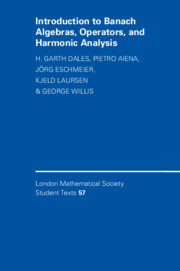Book contents
- Frontmatter
- Contents
- Preface
- Part I Banach algebras
- Part II Harmonic analysis and amenability
- Part III Invariant subspaces
- Part IV Local spectral theory
- Part V Single-valued extension property and Fredholm theory
- 26 Semi-regular operators
- 27 The single-valued extension property
- 28 SVEP for semi-Fredholm operators
- Index of symbols
- Subject index
26 - Semi-regular operators
Published online by Cambridge University Press: 29 December 2009
- Frontmatter
- Contents
- Preface
- Part I Banach algebras
- Part II Harmonic analysis and amenability
- Part III Invariant subspaces
- Part IV Local spectral theory
- Part V Single-valued extension property and Fredholm theory
- 26 Semi-regular operators
- 27 The single-valued extension property
- 28 SVEP for semi-Fredholm operators
- Index of symbols
- Subject index
Summary
Let T be a bounded operator on a Banach space X. It has been observed in Chapter 21 that, if the spectrum σ(T) is totally disconnected, then T is decomposable. In particular, every compact operator K is decomposable, because σ(K) is either finite or a sequence which converges to 0. The classical Riesz–Schauder theory for compact operators shows that, for every λ ≠ 0, the space λI – T has a finite-dimensional kernel and a finite-codimensional range, that is, λI – T is a Fredholm operator, see Part I, Theorem 2.2.5 or Heuser (1982). Similarly, the class of normal operators on a Hilbert space consists of decomposable operators (see Part IV, Chapter 21), and has many remarkable properties from the point of view of Fredholm theory. For instance, for normal operators some of the spectra originating from Fredholm theory coincide, as in the case of compact operators.
A natural question is to what extent the results which hold for compact and normal operators in Fredholm theory may be extended to decomposable operators. In this part of the book we shall give some answers to this question, and establish important connections between Fredholm theory and the single-valued extension property, a property which plays a leading role in the investigation of decomposable operators.
Definitions
Among the various concepts of regularity originating from Fredholm theory, the concept of semi-regularity, which will be introduced in this chapter, seems to be the most appropriate to investigate some important aspects of local spectral theory. The concept of semi-regularity originates in the classical Kato's treatment (1958) of perturbation theory of Fredholm operators.
- Type
- Chapter
- Information
- Publisher: Cambridge University PressPrint publication year: 2003



